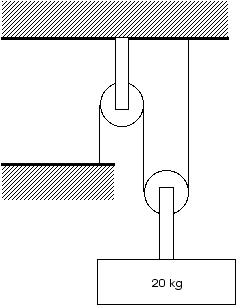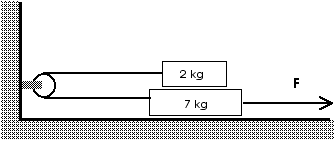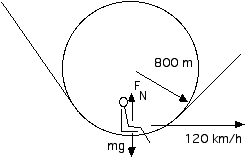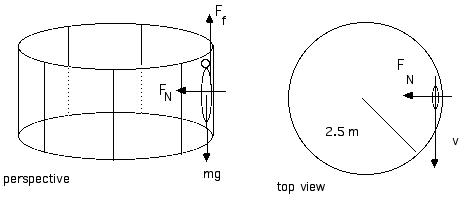
PHY 1151
Doug Davis

PHY 1151
Doug Davis
Ch 6, Applications of Newton's Laws
Friction
Translational Equilibrium
Circular Motion
![]()
| ToC, Chapter 6 | Course Calendar |
![]()
(Friction)
D6.1 A 7-kg package sits on a rough but level floor. The coefficient of sliding friction between the package and the floor is 0.27. A cord is attached to the package and makes an angle of 30° above the horizontal. What must be the tension in the cord to move the package along the surface with an acceleration of 1.0 m/s2?

D6.2 A man pushes a 20-kg lawn mower at constant speed with a force of 80 N directed along the handle, which makes an angle of 37° with the horizontal. Calculate the following:a) the horizontal and vertical components of the man's force.b) the horizontal retarding force on the mower.
c) the normal force between the mower and the lawn (be sure to include the mower's weight).
d) the effective coefficient of friction in this case.
(Translational Equilibrium)
D6.3 A 2-kg ball is held in position by a horizontal string and a string that makes an angle of 30° with the vertical, as shown in the figure. Find the tension T in the horizontal string.
D6.4 The pulleys shown in the figure below are frictionless but have a mass of 4 kg each. What is the tension in the cord and in the pulley supports?

D6.5 A cable and pulley arrangement is shown here. The coefficient of friction between the two blocks is 0.4. The coefficient of friction between the block and the floor is 0.4. What is the maximum external horizontal force F that can be exerted on the lower block before it will move? What is the tension in the cable?

(Circular Motion)
D6.6 A horse moves with a tangential speed of 1.9 m/s when it is 8.5 m from the center of a carousel. Calculate its centripetal acceleration. If a 70-kg person sits on the horse, what is the net force on the rider?
D6.7 A coin sits 15.0 cm from the center of a variable-speed turntable. The coin remains in place as the speed of the turntable increases until it reaches a rate of 2 revolutions per second and then it starts to slide. What is the coefficient of friction between the coin and the surface?
D6.8 A 1200-kg car makes a curve on a flat road of radius 60 m at a speed of 15 m/s. Will the car be able to make the turn if
a) the pavement is dry and has a coefficient of friction of 0.65?
b) there is oil on the pavement and the coefficient of friction is only 0.20?
D6.9 The table below lists data for six banked highway curves-giving the radius of each curve and the angle at which the curve is banked. Find the maximum speed at which these curves may be traveled without depending upon friction and rank them from slowest to fastest
Curve: A B C D E F radius 330 m 350 m 280 m 420 m 180 m 250 m bank angle 5° 3° 11° 5° 8° 10°
D6.10 A 60-kg pilot comes out of a dive by flying along an arc of radius 800 m with a speed at the bottom of 120 km/h. What is her apparent weight?

D6.11 A car of mass 1000 kg goes over the crest of a hill whose radius of curvature is 40 m measured in a vertical plane.
(a) What is the force of the car on the road surface if the car’s speed is 15 m/s?
(b) Calculate the magnitude and direction of the necessary force between car and road if the speed at the top of the crest is 20 m/s. Explain your answer.
D6.12 In the ROTOR ride on a midway, passengers are pressed against the inside vertical wall of a rotating drum 2.5 m in radius. This drum takes 2.0 seconds to make a complete rotation; that is, it rotates at 30 rpm (revolutions/minute).
(Six Flags - St Louis has this ride and there it is known as "Tom's Twister". Take a look at it next summer -- as participant or as observer!)
(a) Viewed from an Earth-based frame of reference outside the drum, what are the magnitude and direction of the force of the wall on a rider whose mass is 70 kg?
Initially the rider’s weight is supported by the floor. After the ROTOR is at full speed the floor is removed.
(b) If the coefficient of static friction between the passenger and the wall is 0.6, will the passenger slip or be held pressed against the vertical wall?
(c) Describe the situations -- including the forces -- from the reference frame of the passenger.
| ToC, Chapter 6 | Course Calendar |
(c) 2005, Doug Davis; all rights reserved
| ToC, Chapter 6 | Course Calendar |
![]()
(c) 2005, Doug Davis; all rights reserved